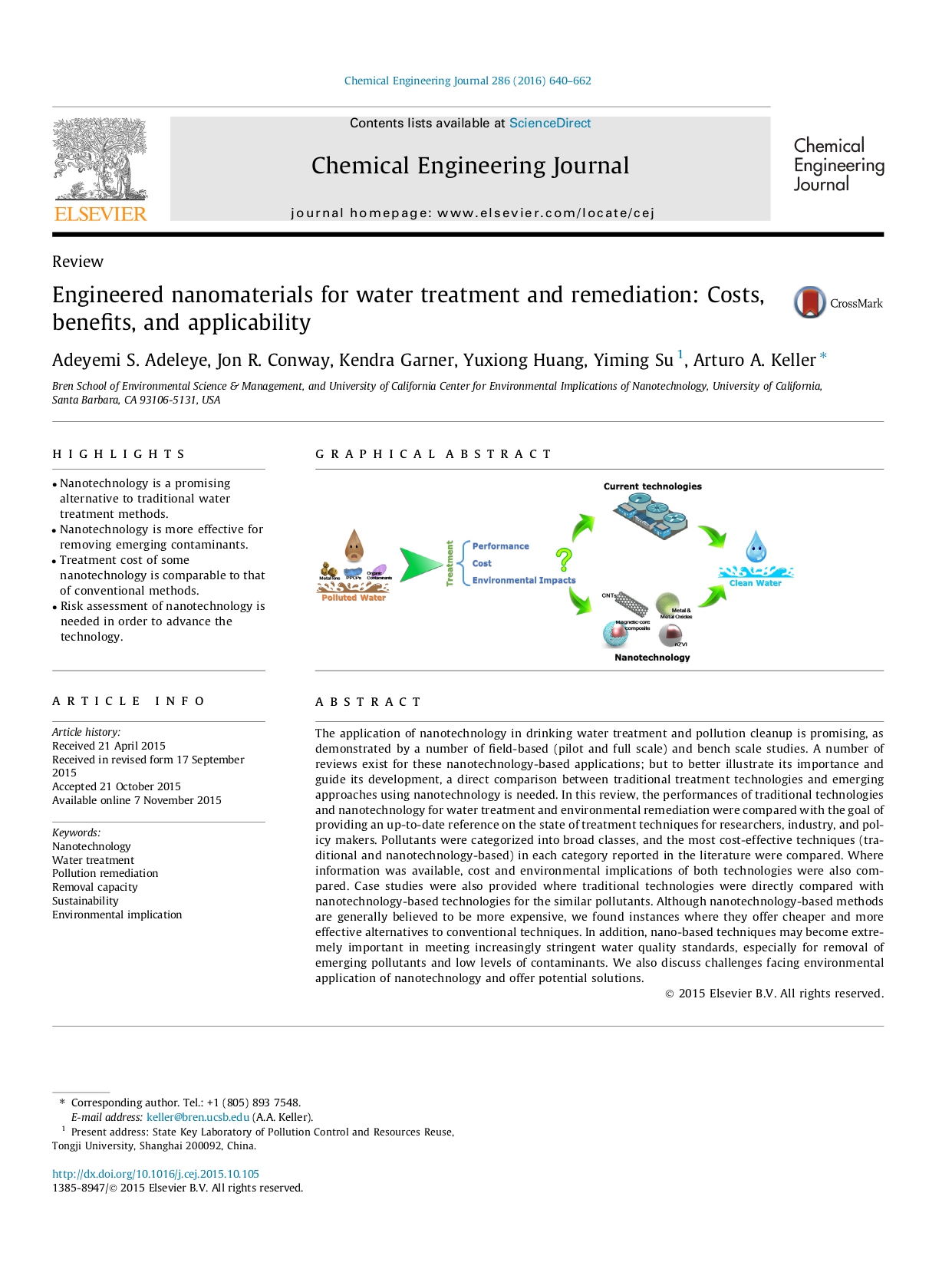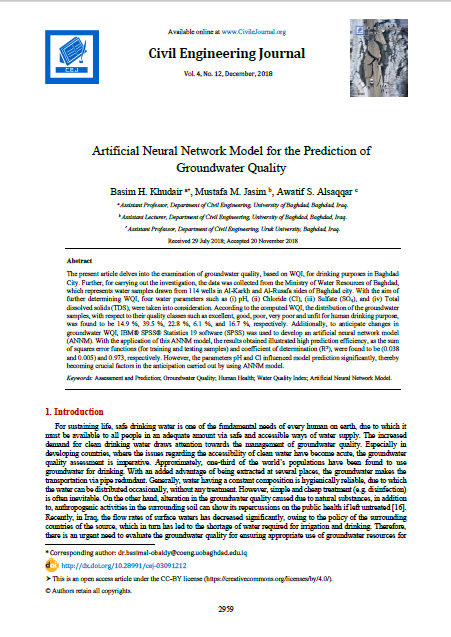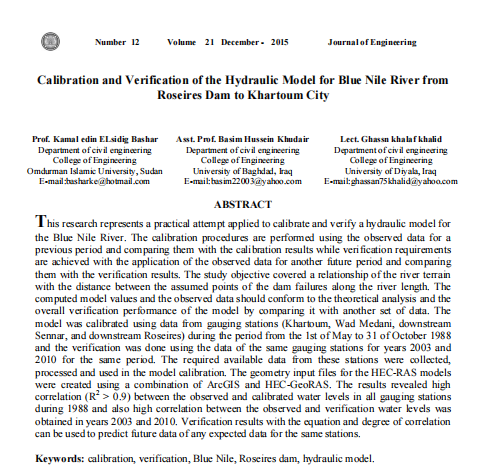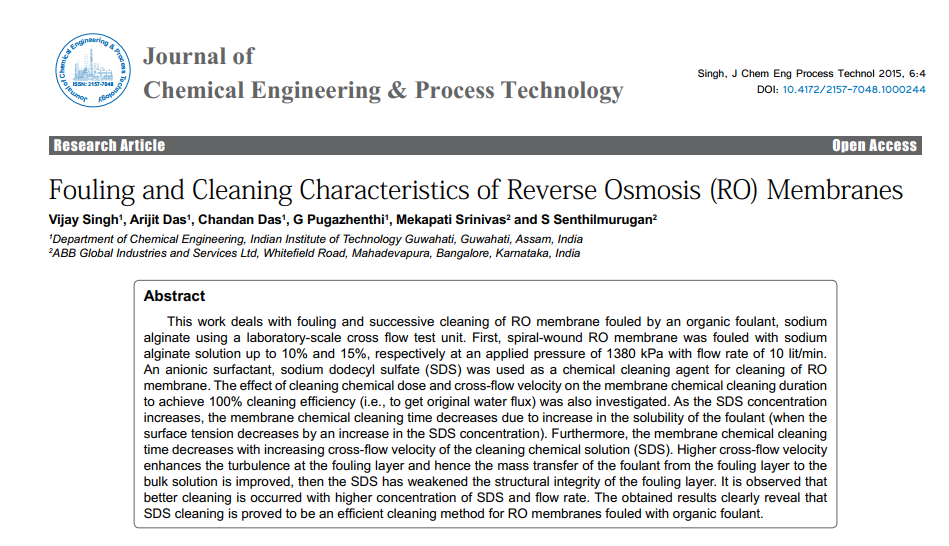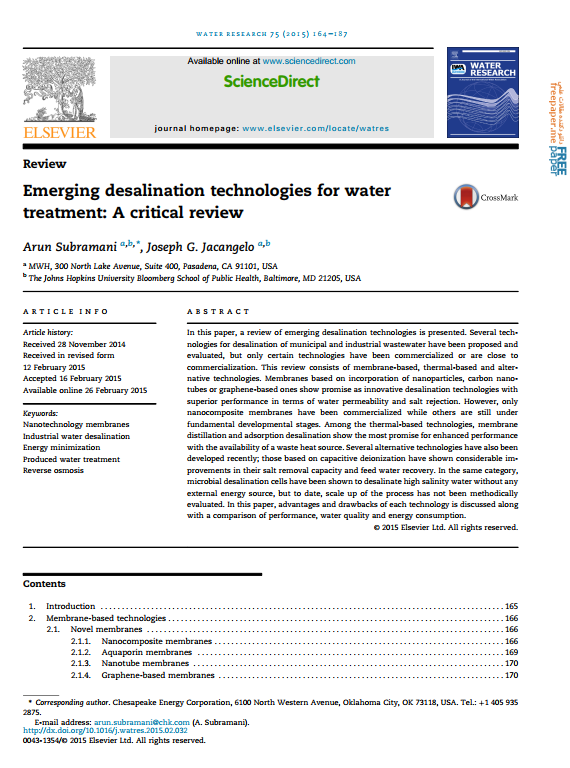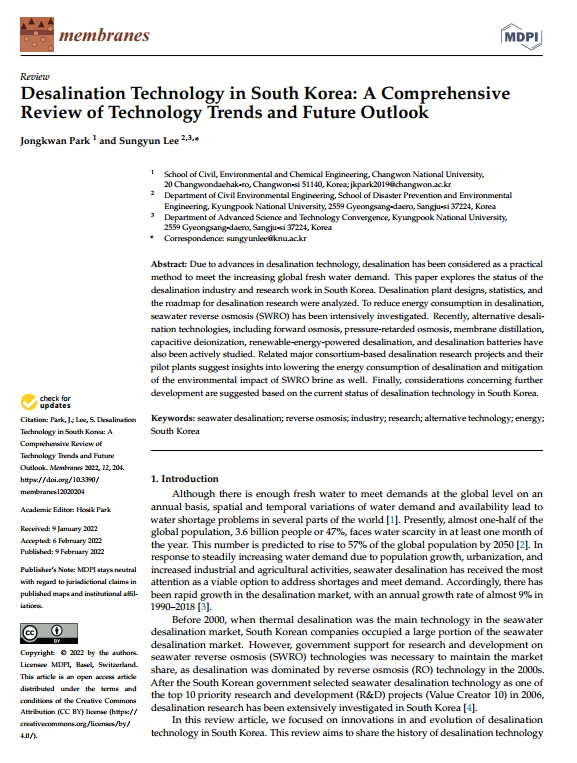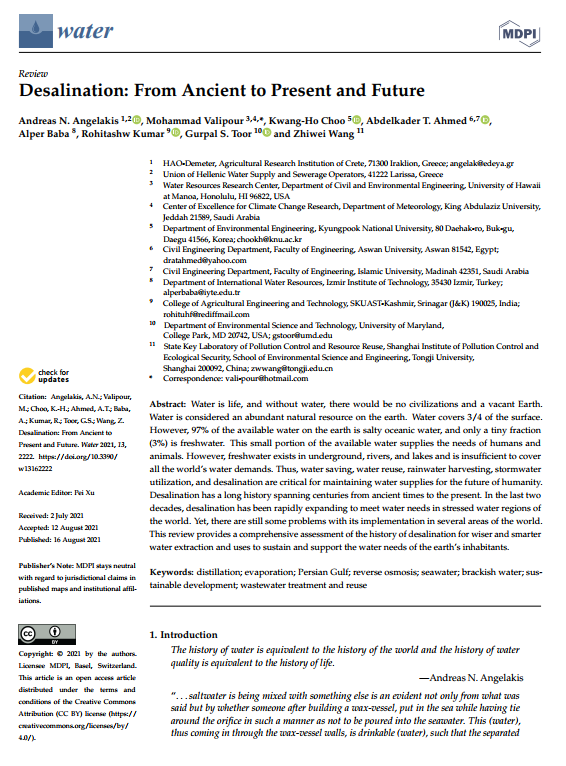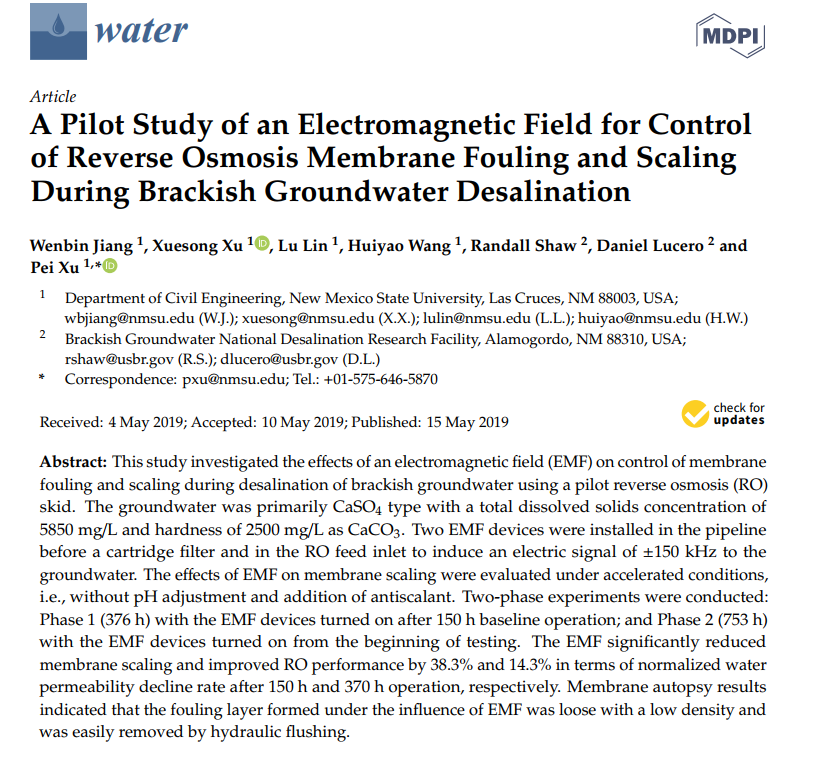Engineered Nanomaterials for Water Treatment and Remediation
Water is one of the world’s most abundant resources, but less than 1% of the global supply of water is available and safe for human consumption [1]. According to the World Health Organization, over 760 million people were without adequate drinking water supply in 2011 [2]. Where it is available, the cost of potable water is rising due to increasing energy costs, growing populations, and climatic or other environmental issues [1,3]. In addition, an increasing number of drinking water sources are showing evidence of contamination, especially by emerging pollutants like pharmaceuticals and personal care products [4,5]. Many traditional water and wastewater treatment methods do not effectively remove these emerging contaminants, and/or are not capable of removing enough to meet increasingly stringent water quality standards [5,6]. Contamination of surface waters also constitutes a risk to water supplies because pollutants may penetrate into aquifers, where they can be transported to drinking water sources.
Engineered Nanomaterials for Water Treatment and Remediation
Water is one of the world’s most abundant resources, but less than 1% of the global supply of water is available and safe for human consumption [1]. According to the World Health Organization, over 760 million people were without adequate drinking water supply in 2011 [2]. Where it is available, the cost of potable water is rising due to increasing energy costs, growing populations, and climatic or other environmental issues [1,3]. In addition, an increasing number of drinking water sources are showing evidence of contamination, especially by emerging pollutants like pharmaceuticals and personal care products [4,5]. Many traditional water and wastewater treatment methods do not effectively remove these emerging contaminants, and/or are not capable of removing enough to meet increasingly stringent water quality standards [5,6]. Contamination of surface waters also constitutes a risk to water supplies because pollutants may penetrate into aquifers, where they can be transported to drinking water sources.
Artificial Neural Network Model for the Prediction of Groundwater Quality
The present article delves into the examination of groundwater quality, based on WQI, for drinking purposes in Baghdad City. Further, for carrying out the investigation, the data was collected from the Ministry of Water Resources of Baghdad, which represents water samples drawn from 114 wells in Al-Karkh and Al-Rusafa sides of Baghdad city. With the aim of further determining WQI, four water parameters such as (i) pH, (ii) Chloride (Cl), (iii) Sulfate (SO4), and (iv) Total dissolved solids (TDS), were taken into consideration. Additionally, to anticipate changes in groundwater WQI, IBM® SPSS® Statistics 19 software (SPSS) was used to develop an artificial neural network model (ANNM). With the application of this ANNM model, the results obtained illustrated high prediction efficiency, as the sum of squares error functions (for training and testing samples) and coefficient of determination (R2), were found to be (0.038 and 0.005) and 0.973, respectively.
Artificial Neural Network Model for the Prediction of Groundwater Quality
The present article delves into the examination of groundwater quality, based on WQI, for drinking purposes in Baghdad City. Further, for carrying out the investigation, the data was collected from the Ministry of Water Resources of Baghdad, which represents water samples drawn from 114 wells in Al-Karkh and Al-Rusafa sides of Baghdad city. With the aim of further determining WQI, four water parameters such as (i) pH, (ii) Chloride (Cl), (iii) Sulfate (SO4), and (iv) Total dissolved solids (TDS), were taken into consideration. Additionally, to anticipate changes in groundwater WQI, IBM® SPSS® Statistics 19 software (SPSS) was used to develop an artificial neural network model (ANNM). With the application of this ANNM model, the results obtained illustrated high prediction efficiency, as the sum of squares error functions (for training and testing samples) and coefficient of determination (R2), were found to be (0.038 and 0.005) and 0.973, respectively.
Calibration And Verification Of The Hydraulic Model For Blue Nile River from Roseries Dam To Khartoum City
ABSTRACT:
This research represents a practical attempt applied to calibrate and verify a hydraulic model for the Blue Nile River. The calibration procedures are performed using the observed data for a previous period and comparing them with the calibration results while verification requirements are achieved with the application of the observed data for another future period and comparing them with the verification results. The study objective covered a relationship of the river terrain with the distance between the assumed points of the dam failures along the river length. The computed model values and the observed data should conform to the theoretical analysis and the overall verification performance of the model by comparing it with another set of data. The model was calibrated using data from gauging stations (Khartoum, Wad Medani, downstream Sennar, and downstream Roseires) during the period from the 1st of May to 31 of October 1988 and the verification was done using the data of the same gauging stations for years 2003 and 2010 for the same period. The required available data from these stations were collected, processed and used in the model calibration. The geometry input files for the HEC-RAS models were created using a combination of ArcGIS and HEC-GeoRAS. The results revealed high correlation (R2 ˃ 0.9) between the observed and calibrated water levels in all gauging stations during 1988 and also high correlation between the observed and verification water levels was obtained in years 2003 and 2010. Verification results with the equation and degree of correlation can be used to predict future data of any expected data for the same stations.
Calibration And Verification Of The Hydraulic Model For Blue Nile River from Roseries Dam To Khartoum City
ABSTRACT:
This research represents a practical attempt applied to calibrate and verify a hydraulic model for the Blue Nile River. The calibration procedures are performed using the observed data for a previous period and comparing them with the calibration results while verification requirements are achieved with the application of the observed data for another future period and comparing them with the verification results. The study objective covered a relationship of the river terrain with the distance between the assumed points of the dam failures along the river length. The computed model values and the observed data should conform to the theoretical analysis and the overall verification performance of the model by comparing it with another set of data. The model was calibrated using data from gauging stations (Khartoum, Wad Medani, downstream Sennar, and downstream Roseires) during the period from the 1st of May to 31 of October 1988 and the verification was done using the data of the same gauging stations for years 2003 and 2010 for the same period. The required available data from these stations were collected, processed and used in the model calibration. The geometry input files for the HEC-RAS models were created using a combination of ArcGIS and HEC-GeoRAS. The results revealed high correlation (R2 ˃ 0.9) between the observed and calibrated water levels in all gauging stations during 1988 and also high correlation between the observed and verification water levels was obtained in years 2003 and 2010. Verification results with the equation and degree of correlation can be used to predict future data of any expected data for the same stations.
Fouling and Cleaning Characteristics of Reverse Osmosis (RO) Membranes
Abstract:
This work deals with fouling and successive cleaning of RO membrane fouled by an organic foulant, sodium alginate using a laboratory-scale cross flow test unit. First, spiral-wound RO membrane was fouled with sodium alginate solution up to 10% and 15%, respectively at an applied pressure of 1380 kPa with flow rate of 10 lit/min. An anionic surfactant, sodium dodecyl sulfate (SDS) was used as a chemical cleaning agent for cleaning of RO membrane. The effect of cleaning chemical dose and cross-flow velocity on the membrane chemical cleaning duration to achieve 100% cleaning efficiency (i.e., to get original water flux) was also investigated. As the SDS concentration increases, the membrane chemical cleaning time decreases due to increase in the solubility of the foulant (when the surface tension decreases by an increase in the SDS concentration). Furthermore, the membrane chemical cleaning time decreases with increasing cross-flow velocity of the cleaning chemical solution (SDS). Higher cross-flow velocity enhances the turbulence at the fouling layer and hence the mass transfer of the foulant from the fouling layer to the bulk solution is improved, then the SDS has weakened the structural integrity of the fouling layer. It is observed that better cleaning is occurred with higher concentration of SDS and flow rate. The obtained results clearly reveal that SDS cleaning is proved to be an efficient cleaning method for RO membranes fouled with organic foulant.
Fouling and Cleaning Characteristics of Reverse Osmosis (RO) Membranes
Abstract:
This work deals with fouling and successive cleaning of RO membrane fouled by an organic foulant, sodium alginate using a laboratory-scale cross flow test unit. First, spiral-wound RO membrane was fouled with sodium alginate solution up to 10% and 15%, respectively at an applied pressure of 1380 kPa with flow rate of 10 lit/min. An anionic surfactant, sodium dodecyl sulfate (SDS) was used as a chemical cleaning agent for cleaning of RO membrane. The effect of cleaning chemical dose and cross-flow velocity on the membrane chemical cleaning duration to achieve 100% cleaning efficiency (i.e., to get original water flux) was also investigated. As the SDS concentration increases, the membrane chemical cleaning time decreases due to increase in the solubility of the foulant (when the surface tension decreases by an increase in the SDS concentration). Furthermore, the membrane chemical cleaning time decreases with increasing cross-flow velocity of the cleaning chemical solution (SDS). Higher cross-flow velocity enhances the turbulence at the fouling layer and hence the mass transfer of the foulant from the fouling layer to the bulk solution is improved, then the SDS has weakened the structural integrity of the fouling layer. It is observed that better cleaning is occurred with higher concentration of SDS and flow rate. The obtained results clearly reveal that SDS cleaning is proved to be an efficient cleaning method for RO membranes fouled with organic foulant.
Emerging desalination technologies for water treatment: A critical review
Abstract:
In this paper, a review of emerging desalination technologies is presented. Several technologies for desalination of municipal and industrial wastewater have been proposed and evaluated, but only certain technologies have been commercialized or are close to commercialization. This review consists of membrane-based, thermal-based and alternative technologies. Membranes based on incorporation of nanoparticles, carbon nanotubes or graphene-based ones show promise as innovative desalination technologies with superior performance in terms of water permeability and salt rejection. However, only nanocomposite membranes have been commercialized while others are still under fundamental developmental stages. Among the thermal-based technologies, membrane
distillation and adsorption desalination show the most promise for enhanced performance with the availability of a waste heat source. Several alternative technologies have also been developed recently; those based on capacitive deionization have shown considerable improvements in their salt removal capacity and feed water recovery. In the same category, microbial desalination cells have been shown to desalinate high salinity water without any external energy source, but to date, scale up of the process has not been methodically evaluated. In this paper, advantages and drawbacks of each technology is discussed along with a comparison of performance, water quality and energy consumption.
Emerging desalination technologies for water treatment: A critical review
Abstract:
In this paper, a review of emerging desalination technologies is presented. Several technologies for desalination of municipal and industrial wastewater have been proposed and evaluated, but only certain technologies have been commercialized or are close to commercialization. This review consists of membrane-based, thermal-based and alternative technologies. Membranes based on incorporation of nanoparticles, carbon nanotubes or graphene-based ones show promise as innovative desalination technologies with superior performance in terms of water permeability and salt rejection. However, only nanocomposite membranes have been commercialized while others are still under fundamental developmental stages. Among the thermal-based technologies, membrane
distillation and adsorption desalination show the most promise for enhanced performance with the availability of a waste heat source. Several alternative technologies have also been developed recently; those based on capacitive deionization have shown considerable improvements in their salt removal capacity and feed water recovery. In the same category, microbial desalination cells have been shown to desalinate high salinity water without any external energy source, but to date, scale up of the process has not been methodically evaluated. In this paper, advantages and drawbacks of each technology is discussed along with a comparison of performance, water quality and energy consumption.
Desalination Technology in South Korea: A Comprehensive Review of Technology Trends and Future Outlook
Abstract:
Due to advances in desalination technology, desalination has been considered as a practical method to meet the increasing global fresh water demand. This paper explores the status of the desalination industry and research work in South Korea. Desalination plant designs, statistics, and
the roadmap for desalination research were analyzed. To reduce energy consumption in desalination, seawater reverse osmosis (SWRO) has been intensively investigated. Recently, alternative desalination technologies, including forward osmosis, pressure-retarded osmosis, membrane distillation, capacitive deionization, renewable-energy-powered desalination, and desalination batteries have also been actively studied. Related major consortium-based desalination research projects and their pilot plants suggest insights into lowering the energy consumption of desalination and mitigation of the environmental impact of SWRO brine as well. Finally, considerations concerning further development are suggested based on the current status of desalination technology in South Korea.
Desalination Technology in South Korea: A Comprehensive Review of Technology Trends and Future Outlook
Abstract:
Due to advances in desalination technology, desalination has been considered as a practical method to meet the increasing global fresh water demand. This paper explores the status of the desalination industry and research work in South Korea. Desalination plant designs, statistics, and
the roadmap for desalination research were analyzed. To reduce energy consumption in desalination, seawater reverse osmosis (SWRO) has been intensively investigated. Recently, alternative desalination technologies, including forward osmosis, pressure-retarded osmosis, membrane distillation, capacitive deionization, renewable-energy-powered desalination, and desalination batteries have also been actively studied. Related major consortium-based desalination research projects and their pilot plants suggest insights into lowering the energy consumption of desalination and mitigation of the environmental impact of SWRO brine as well. Finally, considerations concerning further development are suggested based on the current status of desalination technology in South Korea.
Desalination: From Ancient To Present And Future
Abstract:
Water is life, and without water, there would be no civilizations and a vacant Earth. Water is considered an abundant natural resource on the earth. Water covers 3/4 of the surface. However, 97% of the available water on the earth is salty oceanic water, and only a tiny fraction (3%) is freshwater. This small portion of the available water supplies the needs of humans and animals. However, freshwater exists in underground, rivers, and lakes and is insufficient to cover all the world’s water demands. Thus, water saving, water reuse, rainwater harvesting, stormwater utilization, and desalination are critical for maintaining water supplies for the future of humanity. Desalination has a long history spanning centuries from ancient times to the present. In the last two decades, desalination has been rapidly expanding to meet water needs in stressed water regions of the world. Yet, there are still some problems with its implementation in several areas of the world. This review provides a comprehensive assessment of the history of desalination for wiser and smarter water extraction and uses to sustain and support the water needs of the earth’s inhabitants.
Desalination: From Ancient To Present And Future
Abstract:
Water is life, and without water, there would be no civilizations and a vacant Earth. Water is considered an abundant natural resource on the earth. Water covers 3/4 of the surface. However, 97% of the available water on the earth is salty oceanic water, and only a tiny fraction (3%) is freshwater. This small portion of the available water supplies the needs of humans and animals. However, freshwater exists in underground, rivers, and lakes and is insufficient to cover all the world’s water demands. Thus, water saving, water reuse, rainwater harvesting, stormwater utilization, and desalination are critical for maintaining water supplies for the future of humanity. Desalination has a long history spanning centuries from ancient times to the present. In the last two decades, desalination has been rapidly expanding to meet water needs in stressed water regions of the world. Yet, there are still some problems with its implementation in several areas of the world. This review provides a comprehensive assessment of the history of desalination for wiser and smarter water extraction and uses to sustain and support the water needs of the earth’s inhabitants.
A Review of the Water Desalination Technologies
Abstract: Desalination is commonly adopted nowadays to overcome the freshwater scarcity in
some areas of the world if brackish water or salt water is available. Different kinds of technologies
have been proposed in the last century. In this paper, the state of the mainstream solutions is
reported, showing the current commercial technologies like reverse osmosis (RO), Multi-Stages Flash
desalination (MSF) and Multi-Effect Distillation (MED), and the new frontiers of the research with
the aim of exploiting renewable sources such as wind, solar and biomass energy. In these cases,
seawater treatment plants are the same as traditional ones, with the only difference being that they
use a renewable energy source. Thus, classifications are firstly introduced, considering the working
principles, the main energy input required for the treatment, and the potential for coupling with
renewable energy sources. Each technology is described in detail, showing how the process works
and reporting some data on the state of development. Finally, a statistical analysis is given concerning
the spread of the various technologies across the world and which of them are most exploited. In this
section, an important energy and exergy analysis is also addressed to quantify energy losses.
A Review of the Water Desalination Technologies
Abstract: Desalination is commonly adopted nowadays to overcome the freshwater scarcity in
some areas of the world if brackish water or salt water is available. Different kinds of technologies
have been proposed in the last century. In this paper, the state of the mainstream solutions is
reported, showing the current commercial technologies like reverse osmosis (RO), Multi-Stages Flash
desalination (MSF) and Multi-Effect Distillation (MED), and the new frontiers of the research with
the aim of exploiting renewable sources such as wind, solar and biomass energy. In these cases,
seawater treatment plants are the same as traditional ones, with the only difference being that they
use a renewable energy source. Thus, classifications are firstly introduced, considering the working
principles, the main energy input required for the treatment, and the potential for coupling with
renewable energy sources. Each technology is described in detail, showing how the process works
and reporting some data on the state of development. Finally, a statistical analysis is given concerning
the spread of the various technologies across the world and which of them are most exploited. In this
section, an important energy and exergy analysis is also addressed to quantify energy losses.
A Pilot Study of an Electromagnetic Field for Control of Reverse Osmosis Membrane Fouling and Scaling During Brackish Groundwater Desalination
Abstract: This study investigated the effects of an electromagnetic field (EMF) on control of membrane
fouling and scaling during desalination of brackish groundwater using a pilot reverse osmosis (RO)
skid. The groundwater was primarily CaSO4 type with a total dissolved solids concentration of
5850 mg/L and hardness of 2500 mg/L as CaCO3. Two EMF devices were installed in the pipeline
before a cartridge filter and in the RO feed inlet to induce an electric signal of ±150 kHz to the
groundwater. The effects of EMF on membrane scaling were evaluated under accelerated conditions,
i.e., without pH adjustment and addition of antiscalant. Two-phase experiments were conducted:
Phase 1 (376 h) with the EMF devices turned on after 150 h baseline operation; and Phase 2 (753 h)
with the EMF devices turned on from the beginning of testing. The EMF significantly reduced
membrane scaling and improved RO performance by 38.3% and 14.3% in terms of normalized water
permeability decline rate after 150 h and 370 h operation, respectively. Membrane autopsy results
indicated that the fouling layer formed under the influence of EMF was loose with a low density and
was easily removed by hydraulic flushing
A Pilot Study of an Electromagnetic Field for Control of Reverse Osmosis Membrane Fouling and Scaling During Brackish Groundwater Desalination
Abstract: This study investigated the effects of an electromagnetic field (EMF) on control of membrane
fouling and scaling during desalination of brackish groundwater using a pilot reverse osmosis (RO)
skid. The groundwater was primarily CaSO4 type with a total dissolved solids concentration of
5850 mg/L and hardness of 2500 mg/L as CaCO3. Two EMF devices were installed in the pipeline
before a cartridge filter and in the RO feed inlet to induce an electric signal of ±150 kHz to the
groundwater. The effects of EMF on membrane scaling were evaluated under accelerated conditions,
i.e., without pH adjustment and addition of antiscalant. Two-phase experiments were conducted:
Phase 1 (376 h) with the EMF devices turned on after 150 h baseline operation; and Phase 2 (753 h)
with the EMF devices turned on from the beginning of testing. The EMF significantly reduced
membrane scaling and improved RO performance by 38.3% and 14.3% in terms of normalized water
permeability decline rate after 150 h and 370 h operation, respectively. Membrane autopsy results
indicated that the fouling layer formed under the influence of EMF was loose with a low density and
was easily removed by hydraulic flushing


